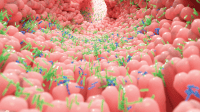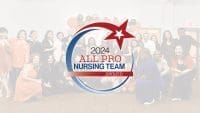Aspiration can lead to serious complications such as aspiration pneumonia, an infectious process from aspiration of oropharyngeal contents. Aspiration pneumonitis refers to direct chemical lung injury from the aspirated material and often cannot be distinguished clinically or radiographically from aspiration pneumonia.
This article takes a closer look at aspiration pneumonia, so that you can feel more confident when caring for patients with this condition.
How we swallow
An understanding of normal swallowing provides the basis for understanding what happens during aspiration. Normal swallowing has three phases: oral, pharyngeal, and esophageal.
During the oral. phase, food is brought into the mouth, moistened, and chewed. The food is brought together into a tight mass so that the tongue may propel this mass into the oropharynx and further to the back of the tongue. From the back of the tongue the mass is propelled by the tongue to the muscles of the pharynx. Poor dentition can decrease chewing efficiency, thus fostering pocketing on the side of the mouth. Pocketed food can later be aspirated.
In the pharyngeal phase, food and liquid are propelled toward the oropharynx, triggering the swallow reflex. Soft-palate elevation prevents food and liquids from entering the nasopharynx. In seconds, the larynx closes involuntarily and breathing is ceased temporarily. The combination of the former two mechanisms prevents food from entering the trachea and lungs. Accessory muscles then move the food into the esophagus with a peristaltic wave.
The esophageal phase uses peristalsis to move the food from the pharynx to the esophagus and on to the stomach. Food is brought down into the stomach through the two esophageal sphincters, upper then lower, which open reflexively as food is brought to the stomach.
What happens during aspiration
During aspiration, the normal swallowing process is disrupted. Bacteria enter the lungs following aspiration of oropharyngeal material that often contains a mixture of aerobic and anaerobic bacteria. Studies show that nearly 50% of healthy adults aspirate, but infection doesn’t’ follow because of the body’s natural defenses, such as coughing, airway ciliary action, low bacterial count in normal secretions, and cellular and humoral mechanisms preventing pneumonia.
Recent studies have questioned the role that anaerobes play, especially given the fact that they are difficult to isolate in expectorated sputum due to contamination from oral pathogens. In hospitalized or nursing-home patients, gram-negative bacilli and Staphylococcus aureus become important causes of aspiration pneumonia. In patients with large-volume aspiration, the aspirated foreign material may cause obstruction of the tracheobronchial tree between the glottis and the distal bronchi. This obstruction causes the usual mucosal cleansing mechanisms to be interrupted, facilitating pathogens to pool and multiply.
How much aspirate is distributed in the lung depends on positioning of the patient during the event. Most patients experience aspiration in the supine position where the aspirate settles in the posterior segment of the upper lobes and the superior segment of the lower lobes. When the person is at a 30-degree angle or more, the opacities usually are in the right lower lobe. With aspiration in the prone position, which is prevalent in drug overdoses and alcoholics, the effect of the aspirate tends to be in the right upper lobe.
The small airways and alveoli are most affected by the damage from chemical or microbial aspiration. This reaction often damages the lung parenchyma, causing fever, cough, or elevation of white cell count. Secondary bacterial infection may occur in the damaged parenchyma, and the patient then develops aspiration pneumonia.
Patients at risk
Of course, not all aspiration events lead to pneumonia. Aspiration pneumonia occurs most often in older patients with swallowing dysfunction, impaired mental status, neurologic diseases, or mechanical impairment of the digestive tract. Aspiration pneumonia is the most common cause of death among patients with swallowing dysfunction related to neurologic disease.
Typical predisposing factors for aspiration in adults are impaired mentation from alcohol abuse, stroke, and other neuromuscular disorders; seizures; and loss of consciousness from other causes.
Other risk factors include:
- patients with swallowing dysfunction who cough during meals or have dyspnea (These patients often tire easily, precluding them from chewing their food thoroughly before swallowing.)
- patients with a history of vomiting
- patients with severe chronic illness whose deconditioning causes them not to chew properly.
Signs and symptoms
Findings of aspiration may include one or several of the following: dyspnea, tachypnea, low oxygen saturation (O2 sat), putrid expectoration, malaise, and frequent coughing. With or without the presence of risk factors, these signs and symptoms require a focused assessment of the lungs. Chest examination may reveal underinflation or poor aeration, or there may be inspiratory crackles on auscultation. The patient may experience fever and rarely pleuritic chest pain. If coughing is productive, the sputum may be frothy, purulent, and putrid.
Diagnosing aspiration pneumonia
Diagnosis is based on clinical signs and symptoms of pneumonia when risk factors and history are consistent with the likelihood of aspiration. Testing usually includes O2 sat, chest X-ray (CXR), complete blood count (CBC), sputum Gram stain, and sputum culture.
CXR is ordered in suspected cases of aspiration occurring with pulmonary signs and symptoms because new infiltrates in dependent regions of the lungs may occur in asymptomatic pneumonia. A CXR, along with clinical signs and symptoms, diagnoses aspiration pneumonia.
The CBC identifies leukocytosis. An arterial blood gas analysis is obtained based on the clinical picture, such as decreasing O2 sat, labored breathing, hypotension, decreased urine output, and other systemic dysfunctions.
The sputum Gram stain is a low-cost test and is easy to obtain in intubated patients. Occasionally this test may identify the infecting organisms, although it’s often inconclusive. When possible, a sample for culture of expectorated sputum should be collected. Culture results are often not informative, but if organism identification and sensitivities are available, the results help guide therapy.
Sometimes blood cultures are ordered, but aspiration pneumonia is usually diagnosed and treated before the results are available. Thus, the usefulness of blood cultures isn’t proven. As with sputum analysis, identification of a specific pathogen in the blood helps to tailor the antibiotic regimen.
Bronchoscopy may be used when the particulate is of large volume, but studies don’t support this intervention. In a nursing home or hospital setting, a lower respiratory sample or a “good” sputum sample is the currently recommended guideline for hospital-acquired and health care–associated pneumonia.
Treatment and support
Antibiotics must be administered immediately after aspiration to treat infection and prevent complications, such as empyema and lung abscesses. Patients with artificial airways (endotracheal tubes or tracheostomies) should be suctioned to keep the airway free of mucus that can block the airway. If the patient is receiving tube feeds, these should be discontinued; the patient should receive nothing by mouth.
Supplementary oxygen to keep O2 sat above 90% should be instituted; management of hypotension, acute respiratory distress syndrome therapy, and septic shock therapy should be considered, because these conditions may ensue if the disease process isn’t halted. Clinical presentation of these patients should direct admission and hospitalization levels. Intubation, altered level of consciousness, and hypotension would justify an intensive care unit admission.
If the patient is intubated or is beyond 48 hours of hospitalization, coverage for pathogens common in hospital-acquired pneumonia, including gram-negative rods and Staphylococcus aureus, should be instituted due to possible colonization with nosocomial organisms.
Antibiotics should be given for 7 to 10 days in patients with aspiration pneumonia. If aspiration occurs in hospitalized patients, traditional regimens have included clindamycin with and without addition of antibiotics to cover for gram-negative pathogens. If pathogens such as Pseudomonas aeruginosa are identified on sputum culture, antibiotics should be continued for 2 weeks. As soon as cultures are available, antibiotics should be tailored based on sensitivity reports.
If patients treated for previous infections are in settings where antibiotics are frequently used, they are likely to be at higher risk for resistant organisms.
Preventing aspiration
Patients at risk for aspiration should undergo a comprehensive swallow evaluation (See Swallow evaluation.)
Swallow evaluationA comprehensive swallow evaluation by a licensed speech pathologist or licensed swallow therapist should include one or more of the following: Clinical assessment. This includes obtaining a history of swallowing difficulty, conducting a sensory and motor exam, and testing the ability of the patient to swallow foods of varying consistencies. The ability of clinical assessments to predict aspiration pneumonia is unclear, but the sensitivity for detection of aspiration is 80%. Videofluoroscopic swallow study. Commonly referred to as modified barium swallow, this commonly ordered test enables the practitioner to see how liquid moves from the mouth into the esophagus. Fiberoptic endoscopic evaluation of swallow. This is a more expensive test for diagnosis of aspiration; however, only the pharynx and larynx can be visualized, and the esophageal and oral phases of swallowing aren’t visualized. |
You can also prevent aspiration by assessing your patient at the beginning of—and during—the shift, checking for signs and symptoms in each of the following categories:
Cognitive function
- Altered consciousness level
- Cognitive impairment
Motor abnormalities with speech and swallowing
- Dysphonia
- Dysarthria
- Inability to clear mucus on coughing
- Poor cough reflex
- Inability to form a bolus of food in the mouth
- Difficulty initiating swallowing
- Inability to close lips
- Food sticking in the throat
- Nasal regurgitation
- Wet voice
- Drooling
- Facial paralysis
- Coughing or choking with swallowing
- Sensation of food sticking in the chest
- Oral or pharyngeal regurgitation
- Inability to control tongue
Miscellaneous
- Unexplained weight loss
- Tachypnea
- Deconditioning
- Change in dietary habits
If any of the above are noted, don’t feed your patient. If there is a swallow protocol (an assessment tool that evaluates the patient’s ability to swallow) at your institution, use it. If there isn’t one, you might institute a best practice by starting one.
Your prompt actions will help protect your patient from further complications.
Dianne McAdams-Jones is an assistant professor in the nursing department at Utah Valley University in Orem. Krishna M. Sundar practices critical care medicine, pulmonology, sleep medicine, and internal medicine in Provo, Utah.
Selected references
Kadowaki M, Demura Y, Mizuno S, et al. Reappraisal of clindamycin IV monotherapy for treatment of mild-to-moderate aspiration pneumonia in elderly patients. Chest. 2005;127:1276-1282. http://chestjournal.chestpubs.org/content/127/4/1276.abstract. Accessed May 15, 2012.
Marik P. Aspiration pneumonitis and aspiration pneumonia. N Engl J Med. 2001;344:665-671. http://www.nejm.org/doi/full/10.1056/NEJM200103013440908. Accessed May 15, 2012.
Paik N-J. Dysphagia. Emedicine. http://emedicine.medscape.com/article/324096-overview. Accessed May 15, 2012.
Varkey AB, Mosenifar Z. Aspiration pneumonia. Emedicine. http://emedicine.medscape.com/article/807600-overview. Accessed May 15, 2012.



















2 Comments.
Use a thickener in his drink
My husband had a aspiration pneumonia, what kind of diet he should have. Also my husband have Lowy body dementia and Parkinson’s. I care about my husband very much and I like to know how can help my husband. Hi is 77 years old and he is very healthy, don’t take any medication except for his disease, never smoked, I love to help my husband, Anna